Registered with the Registrar of Newspapers for India under R.N.I 53640/91
Vol. XXVIII No. 16, December 1-15, 2018
Some progress in restoring heritage
by N.S. Parthasarathy
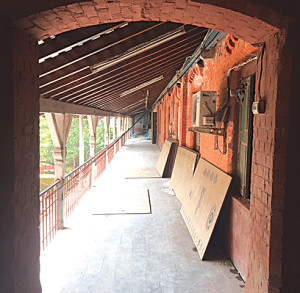 Elegance of the running verandahs.
Elegance of the running verandahs.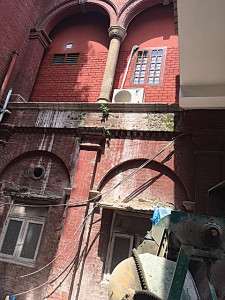 Lower arches vs. restored upper arches.
Lower arches vs. restored upper arches.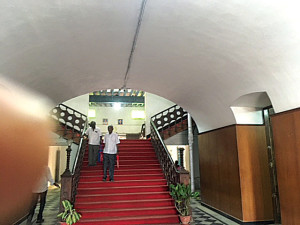 PWD Building entrance with arched ceiling.
PWD Building entrance with arched ceiling.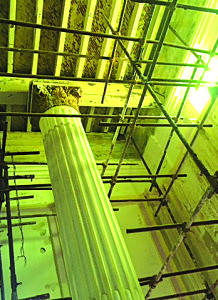 Disentegrating ceiling of Grand Meeting Hall under restoration.
Disentegrating ceiling of Grand Meeting Hall under restoration.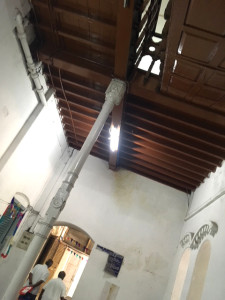 Upper wooden floor held by iron pillar with decorated head.
Upper wooden floor held by iron pillar with decorated head.Last year July, it was in the papers that the Building Centre and Conservation Division (BCCD) of the Tamil Nadu PWD, would be embarking on a major project spread across the State to conserve heritage buildings and that about two hundred such structures had been identified for deeper study to evaluate the needs of each. With the passage of sixteen months it is time to know how the plans have progressed.
In the Public Works Department of Tamil Nadu, a conservation cell in the BCCD is in position, under an Executive Engineer with four teams, stationed in Chennai, Madurai, Coimbatore and Trichy, reporting to him. Each team has three qualified Assistant Engineers and supporting field staff. Formed to hold responsibility for conservation which calls for special sensitivity and skills, it is expected that they will be trained in handling delicate heritage structures. The head of the Conservation cell is, fortunately, a heritage enthusiast and is open to showing round the work completed and those in progress to interested visitors.
The Chennai team of Engineers are academically well qualified and have had exposure to short-term training in heritage restoration and, more importantly, they seem to have acquired valuable experience from working on the High Court, Chepauk Palace and other projects. The enthusiasm of this group suggests that the cause of heritage work would be well served if senior staff are carefully selected for their technical expertise as well as for their aptitude for such specialised work. Once in position, and they take to it with commitment, such staff should have the opportunity to use their experience for a period of five years or longer. Transfers, even after an extended term, should be done by turns and not all or most members of the cell about the same time.
There is no concrete information on the study that was proposed last year of two hundred high priority structures needing attention. This is not to imply that there has been no action on the ground. The fact that estimates for 21 projects for a total of Rs. 94.5 crore have been submitted to the Government for sanction is possibly an indication that these are part, and outcome, of some study. This batch of estimates covers important structures like Chepauk Palace and Humayun Mahal for Rs. 14.04 and Rs. 36.38 crores respectively. The remaining Rs. 44 crore cover the following – Government Press at Mint and Registration Building in Chennai, Governor’s Bungalow in Coimbatore, Collector Office, Court Buildings, Rajah’s College, three Taluk Offices, Collector Residence and Rani’s College in Pudukkottai, and eight structures in Nagercoil/Kanyakumari.
The progress of important projects cannot be ignored when reviewing the Government’s track record on heritage restoration. Restoration of the historic Chennai High Court, of the grandeur of Ripon Building and of the Saracenic grace of the Khas Mahal are important accomplishments. Work on Chepauk Palace is in full swing and may be completed in a year. Work on Victoria Hall likely to start anytime under the Corporation. That sanction is “expected any day now” for the Humayun Mahal, is good news.
Renovation of the High Court has been completed at a cost about Rs. 8 crore. The 125-year-old heritage building of the Madras High Court has been in use continuously for the very purpose for which it was originally intended. Rightly has it been acclaimed that every dome, turret, pillar, column, arch, minaret and staircase of the stately three-storeyed building exudes history. The restored majesty of the Chief Justice’s court hall with its beautifully designed ceiling, decorative wall dados, colour-stained glass panels and intricately carved woodwork, is a tribute to the working team.
Praiseworthy is the fact that about 60,000 metres of cables laid on the ceiling rafters have been removed! The ringing with a wooden club struck on a metal disc is still used to announce the start and closing hours of the court.
After restoration, the Ripon Building, built in 1913, painted in sublime white, and totally different from the Saracenic style, lords over the busy Central area of the City. The programmed illumination of the building changes colours to celebrate different occasions. The restoration cost was about Rs. 23 crore. Imagine that it cost only Rs. 7.5 lakh when it was built by Loganatha Mudaliar 106 years ago!
The renovation of the Chepauk Palace facing the sea, built in 1768 as the official residence of the Nawab of Arcot, now housing the government offices, is in full swing. When finished, in about a year from now, this building with its arches, grand stairs, running verandas, exquisite halls, spiral stairs and stables would make us wonder if it should be wasted on a mundane housing for government offices.
Officials are hopeful of getting the sanction for Rs. 30 crore for Humayun Mahal in a short time. The Humayun Mahal is the biggest project in Chennai not only for its cost but also for its dilapidated state. The Conservation cell is in a state of readiness to launch the process of tendering and selecting experienced contractors for this job immediately on getting the green signal.
Restoration of Victoria Public Hall has had a chequered progress. A beautiful structure, built in 1887, it has not been in use and has been neglected for thirty years. Restoration, started in 2010 with a sanction of Rs. 3.39 crore, was abandoned when the land was taken over for the underground metro rail. It is gathered that the work on it will now be taken up by the Corporation. It is hoped that the experience of the Conservation cell in BCCD will be utilised for overseeing the restoration of this building as it is different from the relatively less complicated Ripon Building executed by the Corporation.
An interesting and challenging job of restoration is that of what goes by the nick name Kudirai Vandi Court, in Coimbatore, built in 1863. It is in very bad condition, overgrown with creepers but, fortunately, retaining enough footprints and vestiges of original design features to make them decipherable for reconstruction. A sum of Rs. 6.6 crore has been sanctioned for this work. The nickname is traced to the Magistrate Court in those days being flooded with prosecutions of horse drawn carts and carriages violating licensing rules. That the legendary, V.O Chidambaram, the Kappalottia Tamizhan, was produced before the magistrate in this building before he was imprisoned in 1908-10 confers an added historic value on this structure.
After restoration, heritage buildings should not be put to strenuous use – crowded offices, heavy public traffic in and out of the buildings. There should be norms that permit only “light” uses. After-care and maintenance are important to avoid frequent need for restoration, each running the risk of drifting away from the original.
The foregoing are symptoms of Government’s concern to save public heritage structures. The pace and available capacity, however, are far too slow and limited for the magnitude of the task on hand. There are several complexities to be overcome. Because of years of neglect many are crumbling and may be lost if not acted upon quickly. Restoration being a specialised job and time-consuming, compared to renovation of normal structures, unit cost is much higher. Contractors with expertise in handling delicate structures and in understanding them are not many. Government’s sanction procedures are too long increasing the risk of losing the treasures for want of timely attention. Efforts to save hundreds of structures, require a large pool of workmanship but that was not available. Adequate and timely funding is needed. A couple of billion rupees could be funded through domestic philanthropic institutions and UN agencies besides the Government’s own equity contribution from the budget consistent with fiscal pressures. Fund availability cannot by itself achieve the objective without the capacity to absorb it.
It is time a State-wide expert inventory, supported by broad financial evaluation and prioritisation, is completed in 69 months. Secondly, technical capacity should be built up speedily at the workmen’s level using our heritage architecture experts, conservation engineers and experienced contractors. We met a 82 year-old contractor who did the High Court and is doing Chepauk Palace, whose family has been specialising in this kind of work for generations. There is no time to lose. Several structures of historical and architectural value are exposed to the risk of being lost forever. Remember, the Bentinck building and Moore Market have been lost for good. For Heritage work, it is a race against time.

